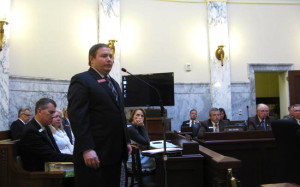Idaho’s ill-fated $61.5 million Schoolnet experiment is all but over.
Now, school districts can choose a substitute: an instructional management system designed to help teachers tailor their lesson plans around students’ strengths and weaknesses.
It’s a big decision for district officials — albeit one subsidized by state dollars. And for education vendors, it’s a market opportunity.
Here’s a look at what’s at stake for students, districts, vendors and taxpayers.
Instructional management system, explained
Let’s start with the basics. What is an IMS, and why is it important?

When an IMS project works properly, teachers are able to use real-time student data to tailor instruction. For example, teachers can administer a pretest before starting a new unit; through an IMS, teachers can make adjustments before launching into the new unit. An IMS guides teachers toward finding learning materials that best fit a student’s needs.
“It’s an incredibly powerful tool because it helps inform your instruction,” said Will Goodman, the State Department of Education’s chief technology officer.
And a strong IMS may be more important than ever, as Idaho moves towards a fundamental shift in the way students move through the school system. Eventually, Idaho wants to abandon its traditional approach — where students move from grade to grade based on seat time — to a mastery-based model that links advancement to command of curriculum. Idaho will begin a mastery pilot later this year.
It would be very hard to make a mastery-based system work without an IMS, Goodman said.
A flawed statewide model
Even before Idaho embraced the mastery model, the state embraced the idea of an IMS. But Idaho’s approach was unproven — and ultimately, its results have been uneven at best.
Former state superintendent Tom Luna pushed for a statewide IMS system, with the idea of linking the IMS to Idaho’s fledgling longitudinal data system. The two data systems serve different purposes: A longitudinal data system largely collects information needed to distribute funding or comply with state or federal law. Luna also wanted a statewide IMS, a concept that hadn’t been tried elsewhere.
Funded largely by state dollars, but also $19.4 million in grants from the J.A. and Kathryn Albertson Family Foundation, the State Department entered into a series of contracts with Pearson Education Inc., to apply its Schoolnet IMS design to a statewide level.

“They’ve never delivered,” Goodman said.
Many districts complained that they could not receive accurate and timely data through the IMS. Some districts purchased other systems on their own nickel, even though Schoolnet was made available free of charge. The Albertson Foundation eventually cut off grant funding.
And on March 23, the state’s Office of Performance Evaluations issued a scathing report that was as much an epitaph as it was an audit.
“Poor management, poor decisions and poor system functionality compounded themselves and prevented the goals for a statewide instructional management system from being realized,” OPE director Rakesh Mohan wrote in the report.
The decision is now up to the districts
Now, districts get to shop for an IMS — and this time, they get to do it on the state’s nickel.
The 2015 Legislature earmarked $2.6 million for districts to shop for their own IMS system. Their cut of the money is based on average daily attendance, and comes to roughly $9 per student.
This isn’t a new course. In 2014, in Luna’s last year in office, the Legislature earmarked money for local IMS purchases. This year, however, there are more strings attached to the money: It must be used for IMS purchases, and can no longer be used for other technology purchases.
The state’s three largest districts are proceeding cautiously.
The Boise School District is considering its options. Nampa will continue working with Pearson, through a direct connection unrelated to the state’s system, and try to figure out what to do beyond 2015-16. The same goes for the West Ada School District.
This is significant — and not just because West Ada is the state’s largest school district. It’s significant because, in a September 2013 legislative hearing, West Ada Curriculum Director Cindy Sisson ripped the state’s system. “I can’t train on a product that’s not accurate,” she said at the time.
But this week, Sisson said West Ada may stay with Pearson. “It depends on how much success we have with the product in 2015-16.”
Vying for market share
Sisson says the new Pearson product has had its ups and downs. On the one hand, she points out that Pearson has assigned a local support staffer to work through West Ada’s issues. On the other hand, she said, the district has had a number of issues.
Test materials have been lost. Because the system wasn’t backed up properly, the district has lost time and money redoing work — and trust in the system has suffered as well.
And that raises a bigger issue. After Schoolnet’s highly publicized and costly problems in Idaho, will districts be willing to give its vendor another try?
“We feel confident each school district will make the right decision for their teachers and students, and we look forward to working with all schools in their pursuit of improving academic success for all students in Idaho,” said Stacy Skelly, a spokeswoman with New York-based Pearson.
Some districts have managed to work with the statewide Schoolnet system, maneuvering around its glitches, Goodman said. So the 2015 Legislature put $985,000 into Schoolnet for 2015-16 — one-time funding to support the districts that still depend on it. But Goodman has only heard from a couple of districts that want to stay on a statewide system beyond 2015-16.
That sets up a battle for market share.
One Boise-based company, Silverback Learning Solutions, senses an opportunity. The company, founded by retired Blaine County Superintendent Jim Lewis, already has contracts with 34 Idaho districts — including some that grew frustrated with Schoolnet and decided to pay for a different IMS. Since the Legislature earmarked $2.6 million for local IMS contracts, Silverback has heard from “several” interested districts, said Rudi Lewis, Jim Lewis’ son and the company’s chief operating officer.
“We definitely are seeing more pickup,” Rudi Lewis said.
The long-term prospects
When the 2016 Legislature convenes, state superintendent Sherri Ybarra will likely come back seeking more IMS funding — probably in the $2.6 million range, Goodman said.
Goodman doesn’t want to handicap the prospects for 2016 and beyond. However, he hopes Ybarra and her staff will be able to show legislators how IMS is making a difference in the schools — including the mastery pilots.

Rep. Wendy Horman, a former Bonneville school trustee who now sits on the Legislature’s Joint Finance-Appropriations Committee, is also reluctant to make predictions. The OPE report on Schoolnet got her colleagues’ attention — especially coming on the heels of the Idaho Education Network contract fiasco and another critical OPE report focused on the longitudinal data system.
For the past couple of sessions, Horman has been lobbying for budget line items that allow districts to shop for a functional IMS. And she believes she at least has support from fellow budget-writers.
“I know there’s a solid understanding on JFAC of the importance of an IMS,” she said.
Disclosure: Idaho Education News is funded through a grant from the J.A. and Kathryn Albertson Family Foundation.
